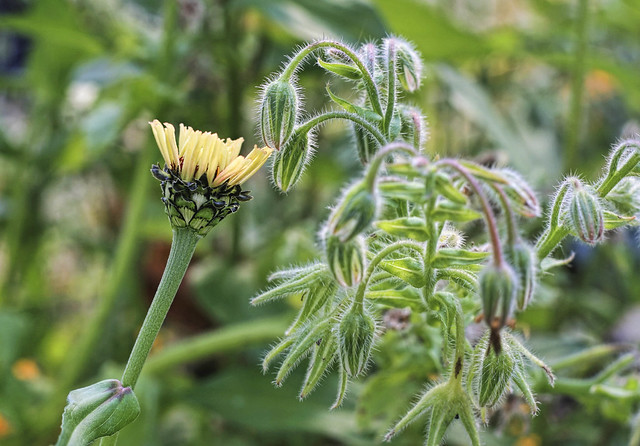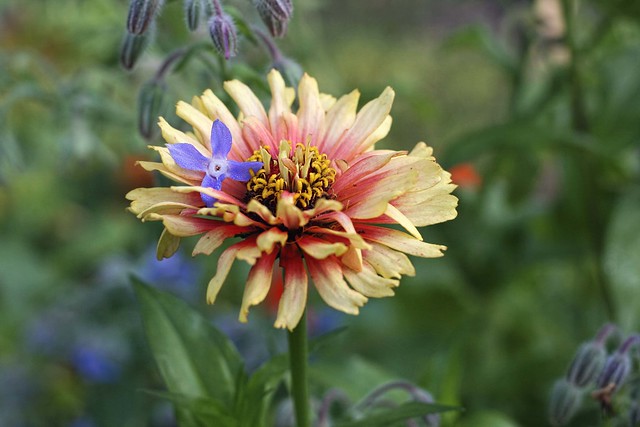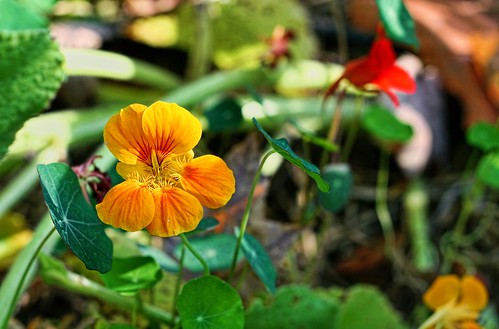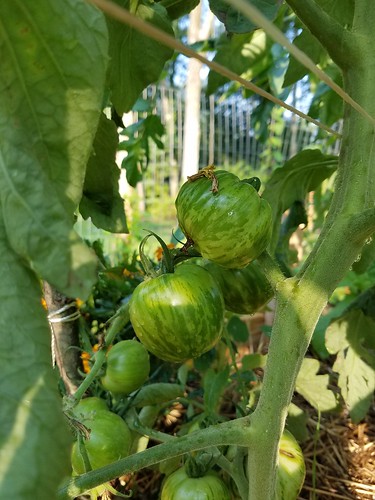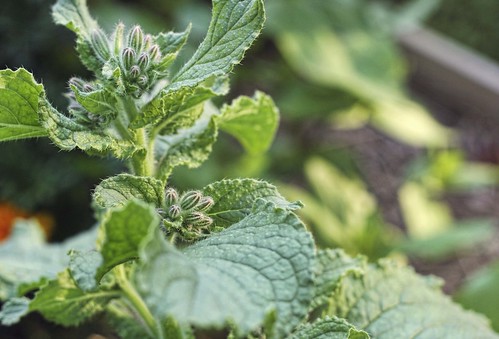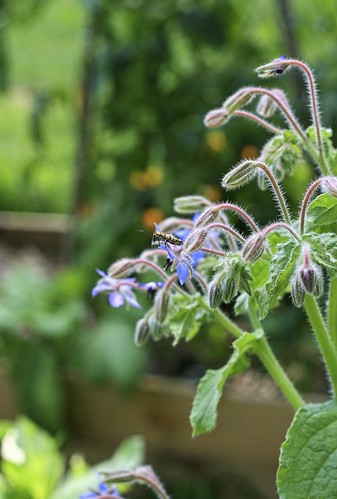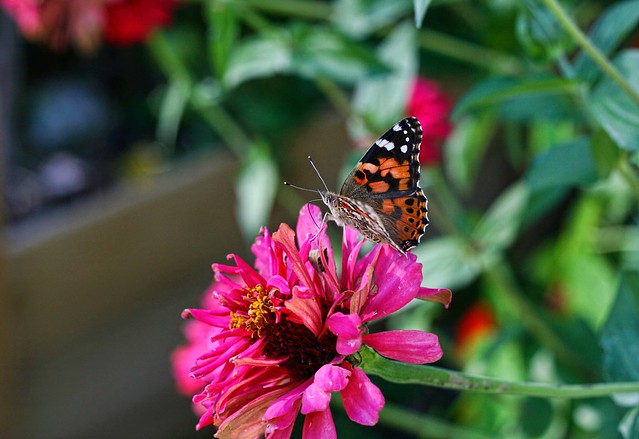Oh, who am I kidding? This post is likely to have 527 photos.
A sad sight greeted my eyes last week (do pardon the tardiness—I also had surgery last week and recovery is taking a bit longer than anticipated): the first hard frost of the season, covering the grass and nearly-denuded trees and, of course, my veggie garden. Ben and I headed out to grab the last (green) tomatoes from the vine to ripen in the garage or be turned into some sort of preserve.
While most of the plants are indeed done for the season, my darling nasturtium actually doesn’t look bad and the youngest borage plants—borage being my other garden flower love—look as fresh as can be, and the same can be said for, of all things, the dill! The Brussels sprouts are fine, too, of course, and will probably taste all the better for the frost.
But for all intents and purposes, 2017’s growing season is over. This weekend I’ll put it to bed, though leaving up the still-blooming plants for as long as I can. Since it’s done for 2017 (my hopes of a winter garden setup having bitten the dust for the coming winter), why not a little tour?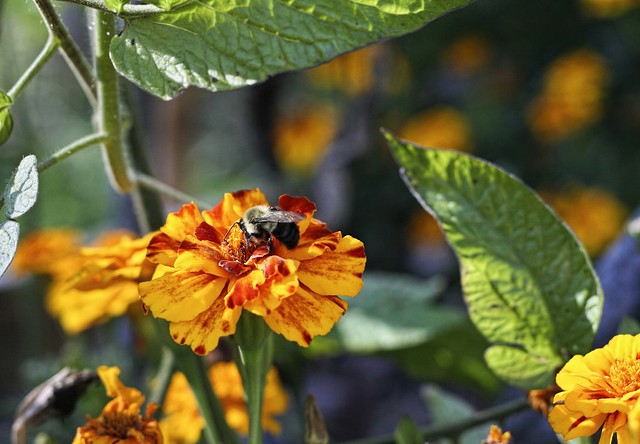
Most of our edibles are grown in raised beds. I sneak them into flowerbeds, too, but the bulk I prefer to keep in the raised beds. Not only is this easier on me physically, the soil warms faster, and here in the woods, it’s much easier to protect our harvest from God’s other creatures via fence! It’s extra work at the outset, but honestly, why people don’t utilize raised beds more often is quite beyond my understanding.

Despise not the day of small beginnings: our newly-built garden in the last week of June. (Lovely cellphone snap.) I used straw mulch, both to keep down weeds and to help the soil stay moist. It’ll also decompose into the soil, making it an overall added value!

The garden in the first week of September. Believe it or not, the flowers continued to explode in growth! Fall is wonderful growing weather.
It must be noted that exactly one week after moving into our sweet little house in the woods, we were dealt a shocking, painful, awful blow I’ve still not come to firm grips with, as evidenced by the fact I cannot even write about it. I didn’t want to do anything at all, though, of course, duties must be fulfilled and I did my best through the grief.
Even so, come mid- June, my beloved and amazing husband returned from the lumberyard with the things necessary to build the beds, lovingly insisting I would indeed garden this year, because as he put it, I love cultivating green things so and it would do me great good and comfort me, even if we didn’t get a single thing to eat from it. As usual, he was right. Oh, that darned patriarchy. Ahem.
We did have irrigation issues from the start—we ought to have had a hose bib installed on each side of the carriage house, but didn’t, something we will rectify when building the big house someday. Ah well. Unfortunately, this meant that as the garden matured, I spent more and more time watering—letting the hose gently dribble water onto each individual plant’s roots for as long as I felt it needed, but usually 15-20 minutes per plant by the height of summer. This meant I was cooling my heels out there for an hour or more a day—doing my best to fill the time by weeding, hanging laundry, plotting landscaping, organizing the garage, playing with Ben and so forth, but it was increasingly impractical even when I was getting up before the sun to do so.
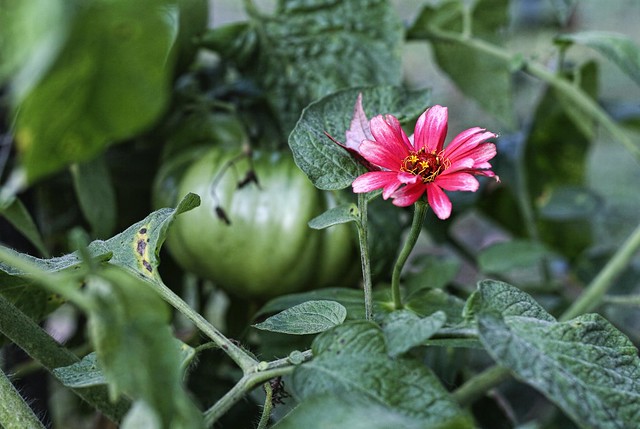
“Hillbilly” and Zinnia
By late August, I believe, we did finally set up an actual semi-automatic system, which I am thrilled with, but I do wonder if the water issue had anything to do with the failure of our “Hillbilly” tomato crop—the plants are beautiful and the tomatoes are tasty, but we didn’t get one edible fruit! Well, not yet; I’ve a few in the garage slowly, slowly ripening. But that was the big disappointment of the season, as I was counting on “Hillbilly” to yield much fruit for putting up and sharing. By October I’d given up on them and yanked them into the compost pile (read: the woods, for now). They were at least fine photography fodder.

Young “Green Zebra”
Happily, the citrusy “Green Zebra” did far better, and served as a delicious side for many meals, as well as being fun to photograph. I’ll miss those! (Of which there are also a few ripening in
the garage.)
In addition to the recently-lauded nasturtium, a plant I’ve adored for years, I also grew borage for the first time. Instant love! The extravagantly sized plants throw up a wealth of slender, fuzzy stems ending in fuzzy teardrops that suddenly burst into beautiful, starlike royal blue blooms. Just gorgeous!
Not only did I love the borage almost beyond reason—yes, yes, it’s simple and ancient, but having never grown it before despite wanting to, I was and remain enamoured of the herb—the bees went nuts for the sapphire-hued flowers as well. Thanks to the borage, my vegetable garden became bumblebee central very quickly, a state of affairs yours truly didn’t mind at all.
Interestingly, the honeybees didn’t show up in great numbers until about September. Hubby and I are both curious as to why this may be; perhaps it took  that long for the scouts to find it? Butterflies arrived by the gross, too, particularly once the zinnias hit full bloom. Three types of visitor, though, were quite unexpected, and one variety a bit less delightful than the other two.
that long for the scouts to find it? Butterflies arrived by the gross, too, particularly once the zinnias hit full bloom. Three types of visitor, though, were quite unexpected, and one variety a bit less delightful than the other two.
A few female hummingbirds frequented the blooms on a regular basis, even resting on the fence or tomato vines. More than once they buzzed me as I watered the beds, perhaps thinking I was a flower because of the colours I wore or, indeed, buzzing the flowers I like to wear in my hair. They’ve long
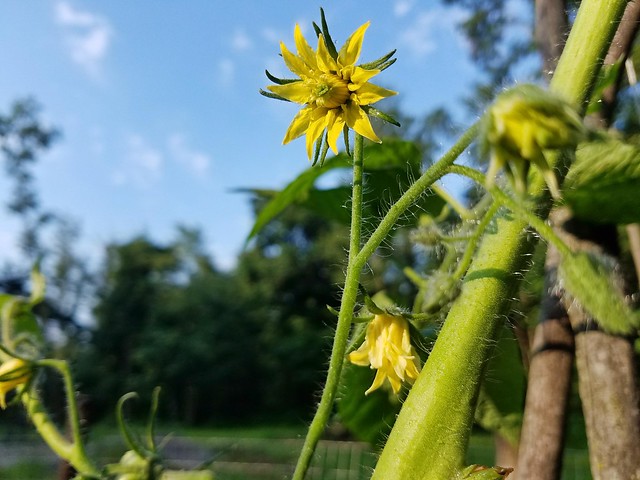
Tiny “Hillbilly” Blossoms
since flown South, but their visits were always enchanting! Having joined the hummingbirds in warmer climes are, of course, the bluebirds who spent two days gamboling about the garden and the woods’ edge not far from it, swinging from the wild grapevines before darting cheerfully to the other side of the clearing, then diving down to land on a tomato or bean plant. (It must be confessed that my Bible study didn’t go so well these two days.) Despite being a bird-lover since childhood, I’d never seen a live bluebird! What a blessing. I do hope they’ll come back next year!
The less delightful visitor? A vulture. I was just beginning to make dinner when a huge shadow seemed to settle onto one of the fenceposts; the bird had decided to rest there a bit, and honestly, he was staring up into the window as I looked down at him, wondering what my problem was. Nowhere near Halloween, either, mind you.
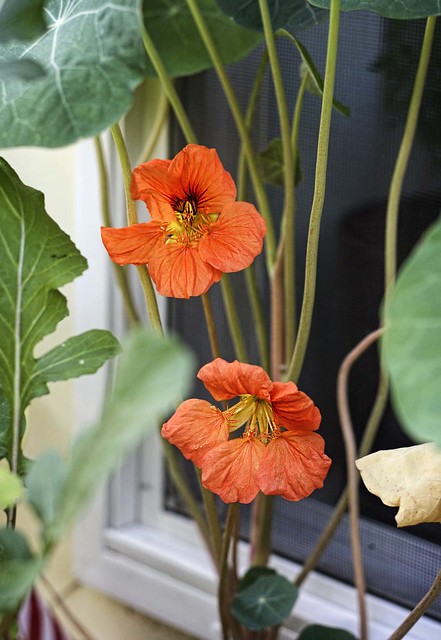
Nasturtium, possibly “Vesuvius”, in a windowbox. (Hey, I forget what I plant where just like anybody else!)
I haven’t many wide shots of the garden, but we surrounded it with cattle fencing to keep the deer, rabbits, and other animals out. It was a successful effort. Being fans of thrift, we used thick branches and fallen saplings to hold the fence up. Upon seeing this, my father thought it was quite resourceful and pioneer-esque, which I’m fine with. Why not? Believe me, they worked just fine! Similarly, we used very tall fallen branches to form tomato teepees, which also served wonderfully. I plan to decorate these for Christmas because I’m a goofball, so they’ll stay up, all decked out, through January.
Green beans are a perennial favourite (well…not really, but you know what I mean) and I tried “Jade” and “Tendergreen Improved”. Both were good, but I think next year we’ll grow “Oregon Blue Lake”, which I’ve grown for years and gotten absurd yield from, too. This was my first year with bush beans; next year, they will be staked or trellised from day one. All I’d read said this wasn’t necessary, but in my opinion it is! At any rate, they provided plenty to eat, plus the blossoms are so very pretty. I’d grow green beans if they never did a thing but look lovely!
The cauliflower were destroyed by a pest I couldn’t get a handle on, especially since I strongly prefer to avoid pesticides; neither pepper plant thrived (next year, the latter will be grown in containers, since that will mean warmer soil); the chives never even bothered to germinate (! watch—next spring, there they’ll be). Such is gardening life. That, I suppose, is one of the reasons God has given us winter: plenty of time to figure out where we went wrong and how to do better next year!
Since we did get such a late start with the garden this year (usually I have it going by late March, planting peas and greens), I knew there wouldn’t be the time necessary time to grow certain crops. Thus many “empty spots” were filled with the aforementioned flowers. Some may consider this a waste, but firstly, these of course draw pollinators to the garden and in some cases, repel pests. Also, some are edible. Nasturtium included, thank you!
Secondly…since when is beauty a waste? It’s not. I’m glad with my decision and intend to continue filling empty spots, however large or small, with many, many flowers. Those flowers (and the creatures visiting them) brought joy to my hurting days, and made the days 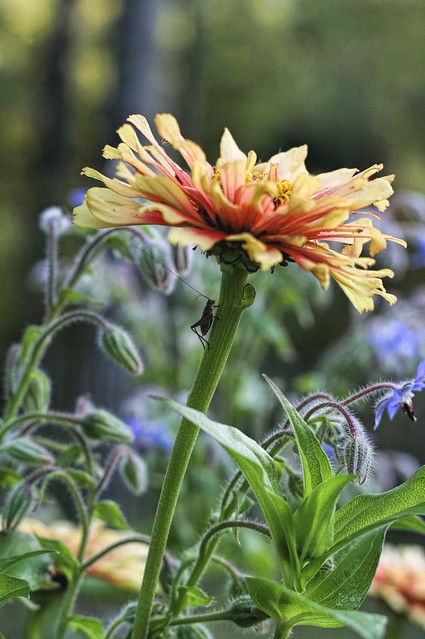 of those who happened to see them (such as our maillady) brighter, too.
of those who happened to see them (such as our maillady) brighter, too.
Frankly, I don’t entirely trust people who don’t think beauty is of value.
By midsummer, the flowers not only made the garden look riotously cheerful, but kind of luxurious—the nasturtium spilling over the edges of the beds, the blue borage sprawling about, the gigantic clumps of marigold, and the tall, proud zinnia doing their best to rival the nine-foot tall tomato plants, the sweet alyssum humbly spreading along the edge of the beds. My heart was lifted with joy and thanksgiving every time my eyes fell over the beds.
A few zinnia and nasturtium were cut to pretty up the indoors, but I do hate taking that food from the pollinators, so must of them stayed outside. Happily, I’ve been rewarded for this with many flower seeds; we’ll see if they do anything next year, though I doubt that stops me from buying more seed (hey, January-April are LONG MONTHS in the Midwest, increasingly full of garden fantasies and dreams).
No gardening season is perfect, but—excuse me if I’ve said this before—I’m very satisfied with this year’s. It was probably more a balm for the soul than for food (good thing, since 2/3 of my potential tomato crop failed!), but sometimes, that is just what we need. There is now all winter to review and to plan next year’s garden, to say nothing of the landscaping, which we let slide this year due to needing other things (like a generator, for instance, in our very rural home, and gravel for the driveway, because trust me, my car will not get through thick mud).
But what do you know…the first seed catalog of 2018 (from—this is not paid, I just like & have good luck with their seeds—the fine folks at Pinetree) arrived today. *bounces off walls in delight* Time to make some tea and curl up for a good read.
Hope you enjoyed the tour-ette!



